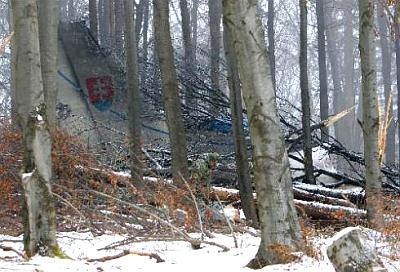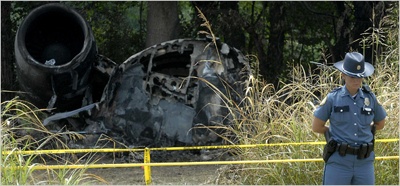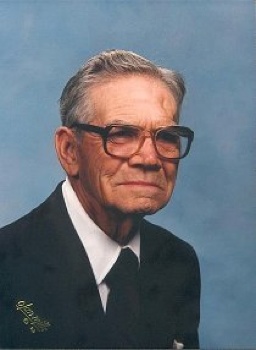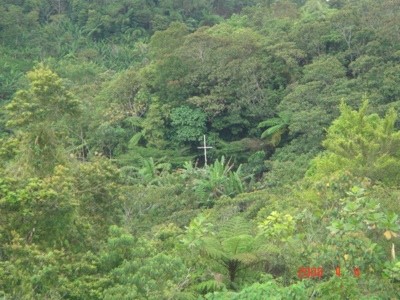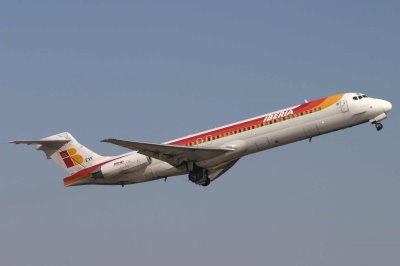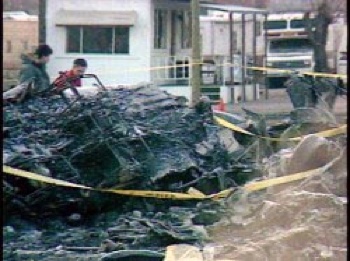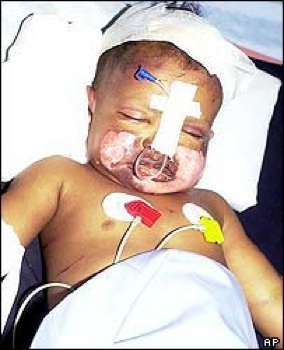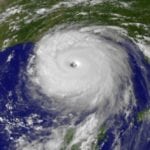Or maybe it is as Forest Gump said: “I don’t know if we each have a destiny, or if we’re all just floating around accidental-like on a breeze, but I think maybe it’s both. Maybe both is happening at the same time”. NOTE: I tried keeping the descriptions short, and that was often difficult. I wanted to include information on the flight, the crash and the survivor. Many sources were used to make this list, so I am fairly confident the general information is correct, but please, if any Listverser knows of any information that is incorrect or want to add some additional facts or information about these air disasters or other sole survivors, please share them. Also it might seem not quite right to put a subject matter like this in a bottom to top list order. Obviously, each incident is just as tragic as the next. The “order” criteria I used was the over all survival story, and the survival chances of each individual.
Date of Crash: January 19, 2006 Aircraft type: Antonov An-24 Operator: Slovak Air Force Crash Site: Hejce, Hungary Passengers & Crew: 43 Fatalities : 42 Cause of Crash: Pilot Error This airplane was carrying Slovak peacekeepers. The aircraft crashed in snowy and forested terrain, on Borsó Hill, at an elevation of 700 meters (2,300 feet), near the Hungarian village of Hejce and the town of Telkibánya. The plane hit the tops of trees, before catching fire and crashing. The bodies and wreckage were scattered over a large area. Michaela Farkasova, the wife of the only survivor, reported that she received a cellular telephone call from her husband, who told her that his plane had crashed in a forest. He asked her to alert rescue services. Shortly after the phone call, Farkas was found. According to rescuers, his survival was pure luck as he was found in the aircraft’s lavatory, which received little damage. Farkaš suffered minor brain swelling and lung injuries after the crash. He was put into a medically induced coma, and was soon reported to be in stable condition. Further investigations indicated that the pilot descended too early in the dark towards the lights of Košice.
Date of Crash: August 27, 2006 Aircraft type: Bombardier Canadair Regional Jet (CRJ) CRJ-100ER Operator : Comair (d/b/a Delta Connection Crash Site: Blue Grass Airport, Lexington, Kentucky Passengers & Crew Onboard: 50 Fatalities: 49 Cause of Crash: Pilot Error This aircraft was assigned the airport’s Runway 22 for the takeoff, but used Runway 26 instead. Runway 26 was too short for a safe takeoff, causing the aircraft to overrun at the end of the runway before it could become airborne, killing all 47 passengers and two of the three crew. The Flights First officer, James Polehinke, was the only survivor. Polehinke suffered serious injuries, including multiple broken bones, a collapsed lung and severe bleeding. Doctors later determined that Polehinke had suffered brain damage, and has no memory of the crash or the events leading up to it. Polehinke was flying the plane when it crashed, but it was the flight’s captain, Jeffrey Clay, who taxied the aircraft onto the wrong runway.
Date of Crash: JUNE 14, 1943 Aircraft type: B-17C Flying Fortress Crash Site: BAKERS CREEK NEAR MACKAY, QLD Australia Passengers & Crew: 41 Fatalities: 40 Cause of Crash: unknown For reasons of military security and morale, this incident was hushed-up by U.S. Army and Australian civil authorities for many years. The plane carried forty-one American servicemen returning from ten days of leave. The aircraft took off into ground fog, and leveled off at an altitude of about 300 feet. In a matter of minutes the plane had caught fire in the air, and as it dived into the trees one of its wings came away, leaving a great opening in the fuselage through which most of the passengers were emptied into the bush before the final impact. The only survivor was Foye Kenneth Roberts. Roberts suffered head injuries that were not diagnosed at the time of the crash, and lost his speech for many years after lifesaving brain surgery. Roberts cannot recall anything of the actual crash. In February 2004, Foye Kenneth Roberts passed away. Another fact that is remarkable is that, still to this day, this crash rates as the worst aviation disaster in Australian history.
Date of Crash: March 17, 1957 Aircraft type: C-47 Skytrain Operator : Philippine Air Force Crash Site: 22 miles NW of Cebu City, Philippines Passengers & Crew: 26 Fatalities: 25 Cause of Crash: Metal fatigue This crash killed the 7th President of the Philippines, Ramon Magsaysay, as well as many high ranking military officials. A reporter for the Philippine Herald, Nestor Mata, was the sole survivor of the accident. The aircraft took off from Lahug Airport for Nichols Field, and eyewitnesses on the ground observed that the airplane had not gained enough altitude as it approached the mountain ranges in Balamban. Mata was sitting in the second seat, next to the President’s compartment, when the crash occurred, and remembers there was a blinding flash for a moment, then he fell unconscious. When he regained consciousness he found himself on the side of a steep cliff among trees and bushes. As he was in agonizing pain, he began shouting, ‘Mr. President! Mr. President!’ When some farmers found him they had to return to the village to get a hammock on which they loaded and carried him for 18 hours through rugged terrain. As soon as Mata reached the Southern Island Hospital in Cebu, he was treated for severe shock and pain from second and third degree burns. Mata did not lose consciousness in the hospital, and was able to dictate to a nurse a press dispatch to his paper. It began ‘President Magsaysay is dead.’ The photo above of the white cross is a “marker” of the exact site of the crash.
Date of Crash: Jan 13, 1995 Aircraft type: DC-9 Operator : Intercontinental airlines Crash Site: Maria La Baja, 500 miles north- west of Bogota Passengers & Crew: 52 Fatalities: 51 Cause of Crash: Unknown This airliner exploded in mid-air as the pilot, apparently, was attempting an emergency landing near a swamp, but hit a grassy field and exploded and then toppled into a lagoon. A farmer said he heard cries for help, and found a 9 year old girl, Erika Delgado, on a mound of seaweed, which had broken her fall. She was the only survivor. She was traveling with her parents and a younger brother, from Bogota to the Caribbean resort city of Cartagena. The rescuers said she told them her mother had shoved her out of the plane as it broke up and burst into flames. She was taken to hospital in shock, and with a broken arm. Erika later recalls someone approached and ignored her cries for help, but ripped a gold necklace from her neck and ran away. Witnesses say scavengers also looted the bodies of other passengers. Erika issued a plea for the return of the necklace, which she says was the only memento of her father.
Date of Crash: January 21, 1985 Aircraft type: Lockheed Electra 188 Crash Site: Reno, Nevada, USA Passengers & Crew: 71 Fatalities: 70 Cause of Crash: Pilot/Ground Crew error After a weekend of skiing, 17 year old George Lamson had taken a seat next to his father in the front row of the airplane’s cabin, directly behind the bulkhead. The plane began to shudder and the plane’s right wing dipped as it began its ill-advised right turn. Lamson pulled his knees to his chest just as the plane hit the ground. The force of the crash ripped Lamson’s seat from the fuselage, and he was catapulted out of the plane, landing upright in the middle of the highway, still strapped in his seatbelt. He unbuckled and dashed toward a field at the far edge of the pavement as the plane exploded. Three people survived the crash initially, including George Lamson’s father, but both died a few days later of severe burns and head injuries. It was later determined that the probable cause of this accident was the captain’s failure to control, and the copilot’s failure to monitor the flight path and airspeed of the aircraft. This is what caused the unexpected vibration shortly after takeoff. Lamson was recently contacted by the press and is a now a father himself. He asked the reporter not to reveal anything more of his work or whereabouts and remains a very private person.
Date of Crash: July 8, 2003 Aircraft type: Boeing 737 Operator : Sudan Airways Crash Site: Port Sudan Passengers & Crew: 116 Fatalities: 115 Cause of Crash: *Unknown About 10 minutes after takeoff heading from Port Sudan on the northeastern coast to the capital, the pilot radioed the control tower about a problem in one engine. The pilot killed that engine and told the tower he was returning to the airport. Ten minutes later, the Sudanese airliner plunged into a hillside while attempting an emergency landing, killing 116 people and leaving 3-year old Mohammed el-Fateh Osman amid a scene of charred corpses, as the only survivor. The boy was found injured and lying on a fallen tree by a nomad. The boy’s mother was among the victims. Mohammed lost part of a lower leg and was treated for severe burns. The bodies were buried in a mass grave after performing the Muslim prayer, because the conditions of the bodies would not allow transporting and delivering them to the relatives. *The country blamed the United States for the crash, saying that sanctions had restricted vital aircraft parts. The United States denied that claim, stating that there was no ban on equipment required for aviation safety.
Date of Crash: January 26, 1972 Aircraft type: McDonnell-Douglas DC-9 Operator: Jugoslovenski Aero transport Cause of Crash: Bombing Crash Site: Hinterhermsdorf , East Germany Passengers & Crew :28 Fatalities: 27 This is close to the top of the list because of the overall circumstances, and the unbelievable survival story of Vesna Vulovi? . Vesna was a flight attendant on board when a bomb went off, at the altitude of 33,000 ft. (10,050 meters). The terrorist act was attributed to Croatian Ustashe terrorists. The explosion tore the jet into several pieces in mid-air. The wreckage fell through the sky for three minutes before striking a frozen mountainside. A German man, upon arriving at the crash, found Vesna lying half outside of the plane, with another crew member’s body on top of her, and a serving cart pinned against her body. The man was a medic in the second world war, and did what he could for her until further help arrived. Vesna’s injuries included a fractured skull, two broken legs and three broken vertebrae, which left her temporarily paralyzed from the waist down. She regained the use of her legs after surgery, and continued working for JAT at a desk job. It was discovered later that her schedule had been mixed up with that of another flight attendant named Vesna, and she was subsequently placed on the wrong flight. Vesna still holds the Guinness World Record for the highest fall survived without a parachute, at 33,330 feet. She is considered a national heroine throughout the former Yugoslavia.
Date of Crash: August 16, 1987 Aircraft type: McDonnell Douglas MD-82 Operator : Northwest Airlines Crash Site: Romulus, Michigan (western Detroit) Passengers & Crew Onboard: 155 Fatalities Onboard: 154 – 2 on the ground were also killed Cause of Crash: Pilot error After taking off from Metro Airport, during the initial climb, the plane rolled about 35 degrees in each direction. The left wing struck a light pole about ½ mile (800 m) from the end of the runway, struck other light poles, the roof of a car rental building, and then the ground. Cecelia Cichan was located by rescue workers in her seat, several feet away from her mother’s body along with Cecelia’s father, and her 6-year-old brother. Her survival of the crash was considered unexplainable and miraculous by many, including airline crash investigators. The National Transportation Safety Board determines that the probable cause of the accident was the flight crew’s failure to use the taxi checklist to ensure the flaps and slats were extended for takeoff. Cecelia is now married and earned a Psychology degree from the University of Alabama. Although she has made no public statements, or attended annual memorial services regarding the tragic crash, she corresponds with some of the crash victims’ loved ones.
Date of Crash: December 24, 1971 Aircraft type: Lockheed Electra L-188A Crash Site: Puerto Inca, Peru Passengers & Crew: 92 Fatalities: 91 Cause of Crash: Human Error and Structural failure, possibly struck by lightning The photo above is Juliane Köpcke sitting near the recreated wreckage for a documentary called Wings of Hope. Contributor: Blogball
